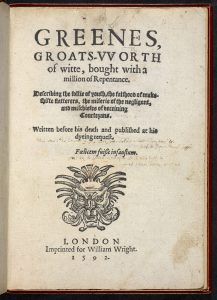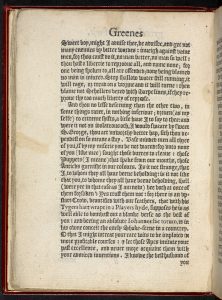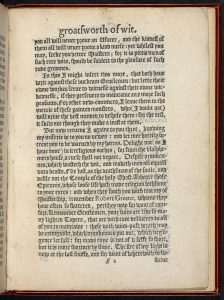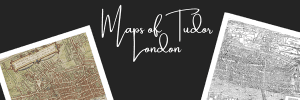William Shakespeare is one of the most celebrated writers in the English language. Born in 1564 in Stratford-upon-Avon, he began his career as an actor in London before turning to writing. Over the course of his career, he wrote 37 plays, including such classics as Romeo and Juliet, Hamlet, and Macbeth. Shakespeare’s work has been translated into more than 80 languages and has been performed more than any other playwright in history. His influence can be seen in countless works of literature, film, and television. However, he wasn’t everyone’s cup of tea.
The first ever printed reference to William Shakespeare was in a pamphlet against his work! It shows that by 1592 he was already making waves in the theatrical world for his writing and had created green-eyed monsters from other playwrights.
Who was Robert Greene?
Robert Greene is best known for his groundbreaking work on the Elizabethan stage. His plays, which include The Tragical History of Doctor Faustus and The Duchess of Malfi, were hugely popular with audiences and helped to shape the course of English drama. Greene was also a highly respected poet, and his work was much admired by his contemporaries. In addition to his literary achievements, Greene was also a noted scholar, and he wrote several important works on rhetoric and poetics. As a result of his many accomplishments, Robert Greene is widely regarded as one of the most important figures in English Renaissance literature.
Before he died in 1592, he wrote a tract called Greenes, Groats-worth of Witte, bought with a million of Repentance. This tract was published as a short book or pamphlet. It was a popular form at the time and it contributed to the lively intellectual life of the time. Robert Greene was an important figure in the development of the English language and literature. He is best known for his works of drama and fiction. However, he also wrote non-fiction works, like Greenes, Groats-worth of Witte, which were popular in their own right. Robert Greene was an important figure in the development of the English language and literature.
Greenes Groats-Worth of witte, bought with a million of Repentance. Describing the follie of youth, the falshood of make-shifte flatterers, the miserie of the negligent, and mischiefes of deceiuing Courtezans. Written before his death and published at his dyeing request. (To those Gentlemen his Quondam acquaintance, that spend their wits in making plaies, R. G. wisheth a better exercise, and wisdome to preuent his extremities.)
Robert Greene, 1558-1592.
London : Imprinted for William Wright, 1592.
Robert Greene’s Dying Wish
Green was a graduate of both Oxford and Cambridge. It was supposedly written on his deathbed and includes public criticism of his various enemies, including Shakespeare, whom he calls ‘an absolute Johannes fac totum’ (or Jack-of-all-trades – a reference to the fact that Shakespeare was an actor as well as a playwright). The phrase ‘upstart crow, beautified with our feathers’ seems to be an accusation of plagiarism, and a criticism of Shakespeare as someone who had not attended university. The description of Shakespeare having a ‘Tygers hart wrapt in a Players hyde’ is a reference to a line from Henry VI, Part 3, where Margaret of Anjou (who also appears in Richard III) is addressed, ‘O tiger’s heart wrapp’d in a woman’s hide!’ (1.4.137).
What did Robert Green write about Shakespeare?
I asked Carol Anne Lloyd from Shakeup History to tell us a little bit more:
“We have public theatres that are actually permanent theatres for the first time, so that players are not wandering around the country performing, there is a physical building that they come to and they perform. And the whole notion of making these plays a playwright who creates the play in this playing company in the theatre and Robert Green believed that world belongs to the university and university trained
and graduates of universities and he took on Shakespeare very specifically in this pamphlet, calling him an upstart Crow beautified with our feathers, that his Tiger’s heart wrapped in a player’s. hide Supposes he is as well, able to bombast out a blank verse as the best of you. So he is, that little idea that Tiger’s heart wrapped in a player’s hide was a jab at Henry the VI.
I mean, he’s just making it very clear that he’s talking about Shakespeare and he’s saying that Shakespeare isn’t well-trained enough and doesn’t belong in this world. So we know by then Shakespeare had been there long enough to make a bit of a name for himself. Cause Robert Greene at the time was very well known and to have annoyed at least one of these trained, acknowledged experts.
So Shakespeare is making a name for himself by 1592. And it’s very much in that London scene where we find him and that’s very important to his career.”
Listen to our Shakespeare’s London: Part 1 podcast episode 85 to find out more.






